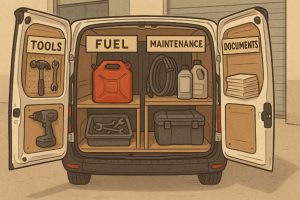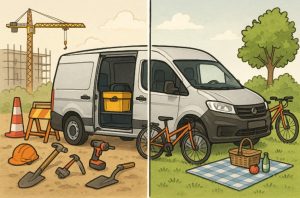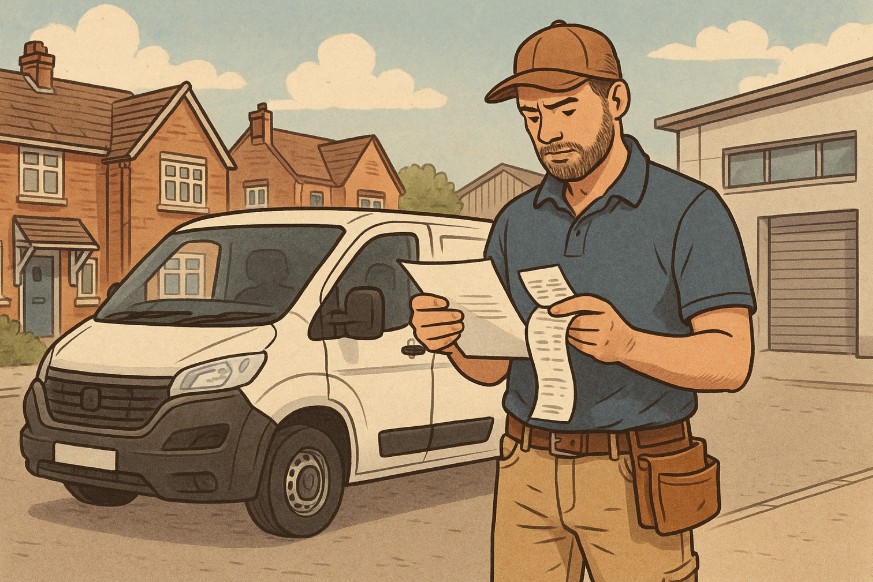Managing expenses efficiently is vital for anyone running a self-employed business in the UK. One key question often raised by self-employed individuals is how much they can claim for using a van for business purposes.
Whether you’re a tradesperson, delivery driver, or mobile technician, understanding HMRC’s rules around van expenses can significantly reduce your tax liability.
This guide breaks down what counts as a claimable expense, how to calculate it accurately, and how to maximise your tax relief.
What Counts as an Allowable Van Expense for the Self-employed?

Allowable van expenses are costs that directly relate to using and maintaining your van for business purposes. If you’re self-employed and use a van as part of your trade, these expenses may be deducted from your taxable profits.
HMRC allows several types of costs to be claimed, provided they are used exclusively for business or appropriately apportioned for mixed use.
Some of the typical allowable van expenses include:
- Insurance premiums for business use
- Repairs, maintenance, and servicing
- Vehicle excise duty (road tax)
- MOT testing fees
- Fuel and oil
- Lease payments or hire charges
- Interest on finance (if the van was bought on credit)
If you’re using the simplified mileage rate, you cannot claim any of these separately, as they’re considered to be included in the per-mile rate.
Can I Claim Tax Relief If I Use My Own Van for Work?
Self-employed individuals can claim tax relief if they use their own van for work purposes. However, this excludes regular commuting to a permanent workplace. The two options available for making claims are:
- Simplified expenses (mileage method): Allows a flat rate per mile driven for business.
- Actual cost method: Allows all running costs and capital allowances to be calculated and deducted.
The simplified method is generally easier and suited for those with straightforward vehicle use. The actual cost method may offer more value for those with higher running or ownership costs.
You cannot switch between methods within the same tax year for the same vehicle. However, you may change methods between tax years.
How Does the HMRC Approved Mileage Rate Work for Vans?

HMRC’s mileage rate for vans is the same as that for cars. It is a fixed allowance that covers all operational costs, including fuel, maintenance, tax, and insurance. The rate is applied based on the number of business miles driven in a tax year.
HMRC Mileage Rates (2024–2025):
| Vehicle Type | First 10,000 Miles | Miles Over 10,000 |
| Cars & Vans | 45p per mile | 25p per mile |
| Motorcycles | 24p per mile | 24p per mile |
| Bicycles | 20p per mile | 20p per mile |
For example, if a self-employed builder drives 12,000 miles in a year, the claim would be:
- 10,000 miles × 45p = £4,500
- 2,000 miles × 25p = £500
- Total claim: £5,000
This rate method removes the need to keep receipts for fuel, insurance, and servicing.
Should I Use Simplified Expenses or Actual Costs for My Van?
Choosing between simplified expenses and actual costs depends on your vehicle usage and total expenses. The simplified method is straightforward, while actual costs require detailed records.
Comparison: Simplified vs Actual Costs
| Criteria | Simplified Expenses | Actual Costs |
| Record-Keeping | Simple mileage log | Full receipts and invoices required |
| Claim for Depreciation | No | Yes (via capital allowance) |
| Covers all Running Costs | Yes | Itemised and claimable separately |
| Suited For | Low-expense users | High-expense or new van owners |
| Switch Between Methods | Yes, per tax year | Yes, per tax year |
If you drive significant mileage but incur low costs, the simplified method may offer the highest return with the least effort.
Those who have purchased an expensive van or incur high maintenance costs may benefit more from the actual cost method.
What Records Do I Need to Keep to Claim Van Expenses?
Keeping accurate and consistent records is essential when claiming van expenses as a self-employed individual. HMRC requires clear documentation to justify any deductions made in your Self Assessment tax return.
The records you need depend on whether you are using the simplified mileage method or claiming actual running costs.
Importance of Proper Record-Keeping
HMRC may ask for proof of your claims during an audit or routine enquiry. Reliable records not only support your claim but also help ensure accuracy when preparing your return.
All documentation should be kept for five years after the 31 January deadline following the end of the tax year.
Records Needed for the Simplified Mileage Method
If you use the simplified mileage rate, you are not required to retain receipts for individual costs like fuel or servicing. Instead, HMRC expects you to maintain a detailed mileage log that includes:
- The date and purpose of each journey
- Start and end locations, ideally with postcodes
- The total number of miles driven for each trip
This log must cover all business-related travel. It’s good practice to record mileage soon after each journey to avoid errors or omissions later.
Records Required for the Actual Cost Method
If you opt for claiming actual van expenses, a more detailed record of your running and ownership costs is necessary. You’ll need to retain receipts and invoices for things such as repairs, insurance, fuel, and vehicle tax. Finance agreements and MOT certificates should also be kept where relevant.
In addition to expenses, you must maintain a mileage log to determine what portion of these costs relate to business use. For vans used partly for personal journeys, a percentage-based calculation will be required.
Tracking Business and Personal Use
Where your van is used for both business and personal purposes, it’s crucial to calculate and document the proportion of business use.
This usually involves comparing your total annual mileage to your business mileage. For example, if 9,000 of 15,000 annual miles are for work, 60% of the total expenses can be claimed.
Accurate mileage tracking allows you to apply the correct proportion to your actual costs, ensuring compliance with HMRC’s guidelines.
How to Store and Manage Your Records?
You can keep your records digitally or in paper form, as long as they are legible and well organised. Many self-employed individuals choose accounting software or apps to manage receipts and mileage logs.
Others prefer spreadsheets or written records. Whichever method you choose, consistency is key.
Record Retention Period
For Self Assessment purposes, records must be kept for five years from the 31 January submission deadline for the relevant tax year. For example, records for the 2023/24 tax year, submitted by 31 January 2025, must be kept until at least 31 January 2030.
Failing to retain the correct records for the required period could lead to HMRC rejecting your claim or issuing a fine.
Can I Claim for a Van Used for Both Business and Personal Use?

When a van is used for both business and personal journeys, only the business-use portion of the expenses can be claimed. HMRC expects claims to reflect only business usage.
To do this accurately, you must track:
- Total mileage in a tax year
- Business mileage
Once you know both figures, calculate the business-use percentage. For example:
- Total mileage: 15,000
- Business mileage: 9,000
- Business-use percentage: 60%
You would then apply this 60% to the total actual costs of running the van for the year to determine your allowable expense claim.
What Happens If My Employer Reimburses Me for Mileage?
When you receive mileage payments from an employer, it can affect what you’re allowed to claim back as tax relief. HMRC provides clear rules to ensure that any mileage reimbursement or tax deduction is fair, without allowing duplicate claims.
Mileage reimbursement typically applies if you’re self-employed taking contract work or if you’re an employee using your own vehicle for business purposes.
Regardless of the arrangement, it’s important to understand how reimbursements interact with the standard mileage allowances provided by HMRC.
How Mileage Reimbursement Affects Your Claim?
HMRC sets approved mileage rates to cover the cost of operating a vehicle for business travel. For cars and vans, the rate is currently 45p per mile for the first 10,000 miles in a tax year and 25p thereafter. These rates are designed to include fuel, insurance, servicing, and wear and tear.
If your employer reimburses you at a lower rate than HMRC’s approved rate, you’re entitled to claim the shortfall as tax relief.
However, if you’re reimbursed at the full approved rate, no additional tax relief is available. And if you’re paid above the approved rate, the excess is treated as taxable income.
Example: Claiming the Shortfall
Imagine you travel 8,000 business miles in a tax year and your employer reimburses you 35p per mile. HMRC allows 45p per mile, which means you’re entitled to claim the remaining 10p per mile.
In this case, your claim would be calculated as follows:
- 8,000 miles × 10p = £800 in tax relief
This amount would be included in your tax return under allowable business expenses or employee expenses, depending on your working status.
Submitting the Claim to HMRC
If you’re self-employed, you’ll report this through your Self Assessment under the business expenses section. If you’re employed and claiming the shortfall, it goes under employment-related expenses.
In either case, you must keep supporting records, including your mileage log and any documentation showing what your employer paid you.
It’s important to claim only the difference between what HMRC allows and what your employer pays, not the full mileage again. Overclaiming could result in penalties or an HMRC investigation.
Relevance for Mixed-Status Workers
If you’re someone who works both as an employee and as a self-employed individual, each role must be accounted for separately.
Keep mileage logs for both types of work, and avoid overlap in your claims. Only business-related travel specific to each role is eligible for relief or reimbursement.
When You Cannot Claim?
You won’t be able to claim additional mileage tax relief if you’re already reimbursed at the full HMRC-approved rate or above. Additionally, mileage related to commuting to a permanent workplace doesn’t qualify for relief under HMRC guidelines.
How Do I Claim Tax Relief for My Van from HMRC?
Tax relief claims for van use must be submitted through your annual Self Assessment tax return. This includes either:
- Entering the total mileage deduction if using simplified expenses
- Itemising the actual costs if using the actual cost method
You can claim for up to four previous tax years if you meet the eligibility criteria and have supporting evidence.
To complete the claim:
- Gather all relevant records (mileage logs, receipts, etc.)
- Choose your preferred claim method
- Calculate the total allowable expense
- Input it into the “Self-employment” section of the return
You can submit the return online via the HMRC portal. Ensure your figures are accurate and supported by documentation.
Is Leasing a Van Better for Tax Relief Than Buying?
Leasing and buying both have tax advantages. The most suitable option depends on your business cash flow, usage, and financial goals.
- Leasing a van: Monthly lease payments are treated as a business expense. This simplifies accounting and often includes servicing and road tax.
- Buying a van: You may claim capital allowances, allowing a percentage of the van’s value to be deducted over time.
For example, with the Annual Investment Allowance (AIA), you may claim 100% of the cost of a new van in the year of purchase, provided it meets HMRC criteria.
Choosing between leasing and buying should consider long-term business needs and potential resale value.
What Are the Common Mistakes Self-employed People Make When Claiming for Vans?

Some of the most frequent mistakes made when claiming van expenses include:
- Claiming personal journeys as business mileage
- Using both simplified and actual cost methods in the same year
- Failing to maintain mileage logs or keep receipts
- Overestimating the business-use percentage
- Not updating claims annually based on vehicle use
Avoiding these mistakes requires maintaining proper records, regularly reviewing your usage, and ensuring your claim aligns with HMRC’s latest guidance.
Conclusion
To get the most from your van expenses, stay organised, choose the method that reflects your true usage and cost, and claim every penny you’re entitled to.
Whether you use a van full-time for work or occasionally, ensuring compliance with HMRC rules is essential. With careful planning, you can significantly reduce your taxable income and improve your cash flow.
FAQs
Can I claim van insurance as an expense if I’m self-employed?
Yes, if you’re using the actual cost method. Under simplified mileage rates, insurance is already covered by the rate.
How often do I need to update my mileage records?
You should update your mileage log daily or weekly to ensure accuracy and compliance with HMRC requirements.
Can I claim for fuel if I already use the mileage rate?
No. The approved mileage rate already accounts for fuel, so claiming it separately would be a duplication.
What if I forget to record some of my journeys?
You may not be able to claim for those journeys unless you can reasonably reconstruct the travel details with supporting documentation.
Does buying a second-hand van affect my tax claim?
No. You can still claim capital allowances on a second-hand van, based on its purchase price.
Can I claim for a van I use only occasionally for work?
Yes, but you’ll need to apportion the expenses based on the percentage of business use.
How do I backdate a claim if I missed the previous tax year?
You can amend your Self Assessment for up to four previous tax years, as long as you have the necessary documentation.








